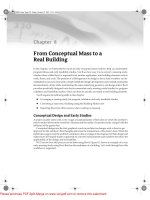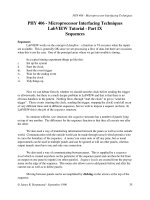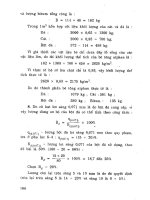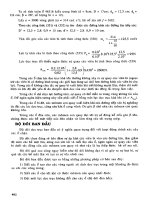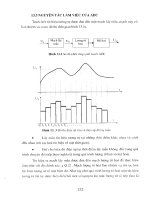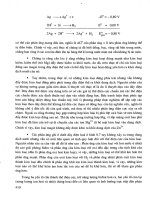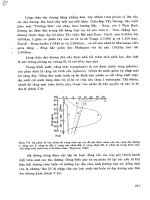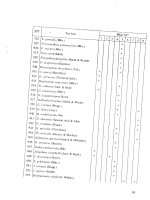Bs 1377 part 9 1990 standard compress
Bạn đang xem bản rút gọn của tài liệu. Xem và tải ngay bản đầy đủ của tài liệu tại đây (227.33 KB, 9 trang )
BS 1377 Part 9 : 1990 Standard
In the design of shallow
foundation or traffic surface,
design engineers need to know
the bearing capacity of soil
underneath. Plate bearing test is
carried out in the field to serve
this purpose. Results from the
test can be used as design
parameter or used to confirm
the design assumption.
The test shall be carried out
in general accordance with
BS !""# Part $ $$% &in'
Situ Tests&.
( circular plate having a
ma)imum diameter of !%% '
*%%mm shall be used.
+)cavate to the test level as
uickly as possible to
minimise the effects of
stress relief, particularly in
cohesive fills. ( mechanical
e)cavator may be used
provided that the e
e)cavator
)cavator
bucket does not have teeth
and the last %%mm depth of
e)cavation is carried out
carefully by hand.
-arefully trim off and
remove all loose material
and any embedded
fragments so that the area
for the plate is generally
level and as undisturbed as
possible.
Protect the test area and the
apparatus from moisture
changes, sunlight and the
effects of adverse weather
as soon as the test level is
e)posed and throughout the
test.
The plate shall be placed on
a thin layer % to /mm
thick0 of clean dry sand to
produce a level surface on
which to bed the plate.
Set up the loading and
deflection, measuring
systems so that the load is
applied to the plate without
eccentricity and the
deflection system is outside
the 1one of influence of the
pattachments.1iplate. 2uring
these operations a small
seating load may be applied
to the plate to enable
ad3ustments to be made#
this seating load shall be
less than /k45m6.
The load shall be applied in
five increments. Settlement
reading will be taken at %./%
minute intervals for the first
6 minutes, and minutes
intervals thereafter, until
detectable movement of the
plate has stopped, i.e. until
the average settlement rate
is less than %.%6mm per /
minute interval.
(t each increment the
pressure shall be maintained
as near as possible constant.
(fter the final test increment
has been completed, the
pressure in the hydraulic
pump shall then be released
and the settlement of the
plate allowed to recover.
7hen the recovery is
essentially complete, the
residual settlement value
shall be recorded.
8ur Range of Pressures start
from % '/%% psi on the
gauge
Test Setup
Equipment and Apparatus
-ounter weight such as bo)
or platform with heavy
material suck as concrete,
steel, etc. Total counter
weight should be at least
%9 greater than the
anticipated ma)imum test
load.
:ydraulic 3ack for applying
the load
Proving ring, kg accuracy,
for measuring the load
Bearing Plate, !/%mm
;/%mm and *%%mm
2iameter
Testing Procedure
Select test location and
depth at the point where the
real foundation will be
constructed, if possible. If
the test is performed in a
test pit, width of the pit
should be at least ; to /
times of plate diameter.
(pply the load to the plate in
steps by means of hydraulic
3ack pushing against the
counter weight until reaching
the ma)imum test load.
=nloading should also be
done in the backward steps.
Read and record the load of
every step from proving
ring.
Read settlement from the
dial gauges. ! to ; dial
gauges should be placed
separately at 6%> or $%>
respectively.
Interpretation of the
Test esu!t
Results from the test shall
consist of raw data, load'
settlement curve, yield pressure,
recommended allowable
pressure for foundation design,
and modulus of subgrade
reaction ?0 for road design.
I!!ustration of Sca!e Effect in "oundation #esign
$oad%sett!ement cur&e from P!ate Bearing Test
2as, B.@. $$/0 suggested
following formula for calculating
bearing capacity of the actual
footing to correct the scale
effect.
"or cohesi&e soi!
qu "or cohesion!ess soi! 'here
qu C. bearing capacity of
footing
u p, bearing capacity of test
plate
B<. breadth of footing
Bp. breadth of test plate
If the above method give too
high bearing capacity, +ngineer
should use 3udgment to limit
allowable pressure to be more
reasonable for each type of soil
condition.
The prediction of settlement can
also be done from the load'
settlement curve from the test.
#etermination of time o&er sett!ement
Ad&antages of the Test
Dain understanding of
foundation behavior which
will enable the evaluation of
foundation bearing capacity
and settlement under
loading condition.
Euick and easy to perform.
$imitations
Plate bearing test can give
bearing capacity of subsoil
up to the depth about twice
of plate diameter only.
There is a scale effect due to
si1e of testing plate is
smaller than the actual
footing.
